Samsung Galaxy S 4 Review - Part 1
by Brian Klug on April 24, 2013 12:01 AM ESTBattery Life and Charge Time
The Galaxy S 4 features a removable 9.88Wh battery with 3.8V chemistry. The battery design is par for the course for any high end smartphone, but the fact that it's removable remains a staple of the Galaxy S design. Whether or not the bulk of consumers actually use the flexiblity offered by a removable battery is up for debate, but there's no doubt about the fact that Samsung has a strong following of users who appreciate the feature.
Unfortunately, only having access to the Sprint version of the Galaxy S 4 to review, most of our battery life tests on the cellular network aren't all that useful. The good news is that our WiFi tests should at least give you an idea of how well the SGS4 will compare to the HTC One when both are on the same network. We're using the latest revision of our smartphone battery life test to compare performance of all the key players here. This is now our sixth revision of the battery life test, and we feel is the optimal balance between challenging workloads and idle time. The basic overview is the same as the previous test — we load webpages at a fixed interval until the handset dies, with display set at exactly 200 nits as always. Power saving features are disabled if they turn on automatically, and background account sync is disabled. The test is performed over both cellular data on all available air interfaces and over WiFi in an environment with good signal levels. The new test has decreased pause time between web page loads and added a number of JavaScript-heavy pages. I sat down with some UMTS RRC (Radio Resource Control) emulator tools and also made sure we had a good balance of all the RRC states (DCH, PCH if possible, FACH, IDLE) so we weren’t heavily biased towards one mode or the other.
As the most relevant comparison of platforms we have today, we'll start with the WiFi version of our web browsing test:
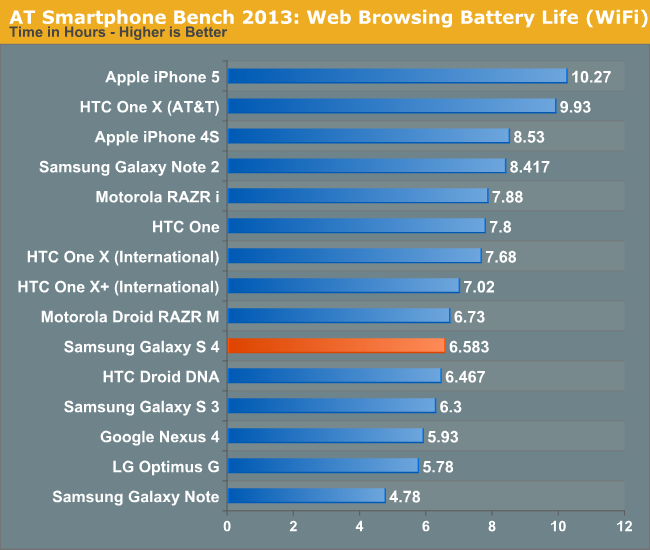
On WiFi the Galaxy S 4 falls behind the HTC One by an appreciable amount, however there's still an improvement in battery life compared to the Galaxy S 3. The Galaxy S 4's battery life isn't bad by any means, but do keep in mind that this is a large phone with a large display and a very powerful SoC. For much of the past year we've been talking about an increase in dynamic range in total platform power of high end smartphones and the Galaxy S 4 is no exception. Run it at full brightness or keep many cores running in their maximum performance states for a considerable period of time and you'll be greeted by a phone that's quickly in need of a power outlet.
As I mentioned earlier, we only have access to the Sprint version of the Galaxy S 4 at this point which unfortunately means that our 3G results aren't all that comparable to other devices here.

Even on Sprint, the Galaxy S 4 does surprisingly well.
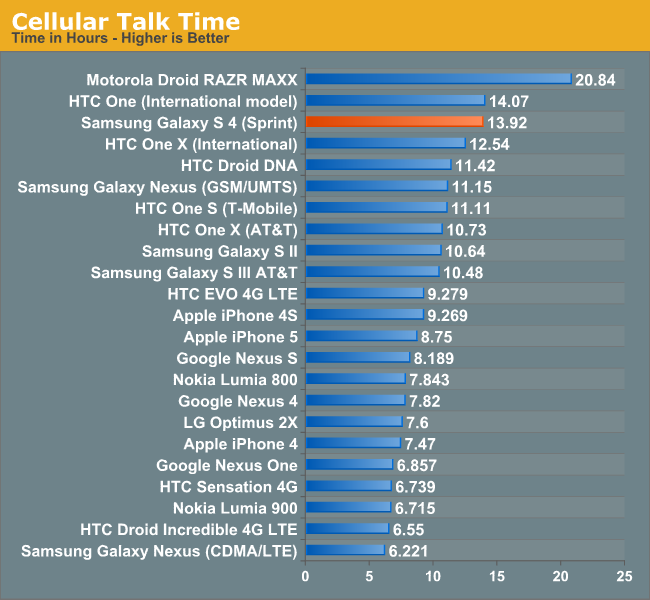
Talk time is excellent on the Galaxy S 4, with the phone delivering effectively the same battery life as the HTC One. Without having to power on that huge display, the Galaxy S 4 can last for a very long time on a single charge.
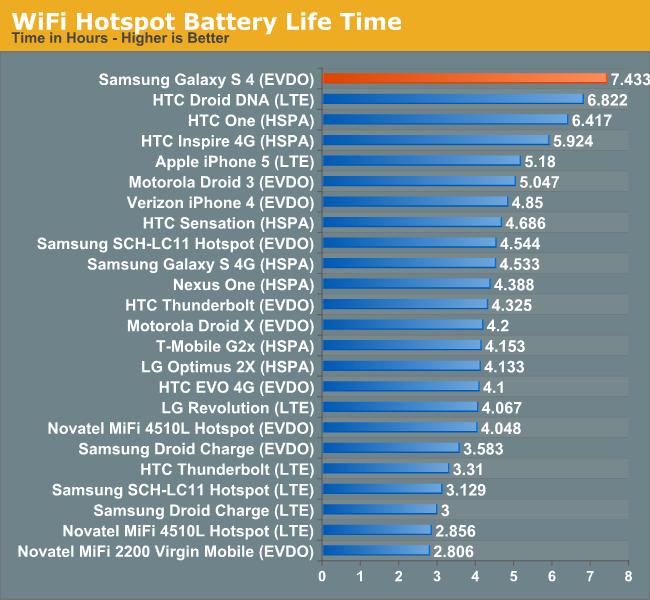
A combination of the Sprint network and the fact that the Galaxy S 4's display remains off during our hotspot test resulted in great battery life here as well. Again, this data isn't all that useful if you're not on Sprint but Samsung tells us we should be able to get our hands on an AT&T SGS4 in the not too distant future.
Charge Time
Samsung appears to implement Qualcomm's Quick Charge specification in the Galaxy S 4 and its bundled charger. I realize we haven't done a deep dive into what Quick Charge is and how it works, but I'll try to go through a quick explanation here. Most conventional chargers are linear, they take a fixed amount of input current (at 5V) and pass it along to the device being charged. The problem is that at deeply discharged states, the device's battery might be at a substantially lower voltage. A traditional linear charger won't change the current supplied based on the voltage of the battery being charged, and as a result can deliver sub-optimal charge times. When implemented, Qualcomm's Quick Charge technology can vary output current based on the voltage of the battery being charged, which results in less power being dissipated as heat and more being delivered to charging the battery itself. The table below helps illustrate the savings:
Quick Charge, at least in its currently available 1.0 specification, is still bound by the 5V limits of the USB BC 1.2 specification. The next revision of Quick Charge will enable higher voltage operation for even faster charge times.
| Qualcomm Quick Charge 1.0, Theoretical Example | ||||||
| Input Current @ Voltage | Input Power | Output Current @ Discharged Battery Voltage | Output Power | |||
| USB BC 1.2 - Linear Charger | 475mA @ 5V | 2.375W | 475mA @ 3V | 1.425W | ||
| Qualcomm Quick Charge 1.0 | 475mA @ 5V | 2.375W | 700mA @ 3V | 2.100W | ||
The non-linear nature of Quick Charge significantly shortens charge time, particularly in the very early stages of charging when the device's battery is presumably fully discharged. As the device's battery voltage increases, current delivery tapers off and the QC advantage is no longer as great as a standard USB BC 1.2 solution. The end result though is significantly improved charge times.
The graph below shows the benefits of using Samsung's own charger vs. a standard charger that implements the USB BC 1.2 specification. When used with the bundled charger, the Galaxy S 4 recharges much faster than HTC's One, despite using a larger battery. Obviously the Galaxy S 4 will charge with any USB charger, but the charge time will simply be longer. Samsung uses a voltage divider and signals the presence of their own charger by sending 1.2-1.3 V across the D+ / D- pins, this is similar to what Apple does with 2.0 or 2.8 V across the pins for various USB chargers they've shipped over the years. This signaling is essentially Samsung's proprietary tablet charging signaling which they've employed on the Galaxy Note 2 and now SGS4, in fact the two use the same exact charger, so it's worth tossing out your old ones and getting the appropriate one to take advantage of the faster charging.
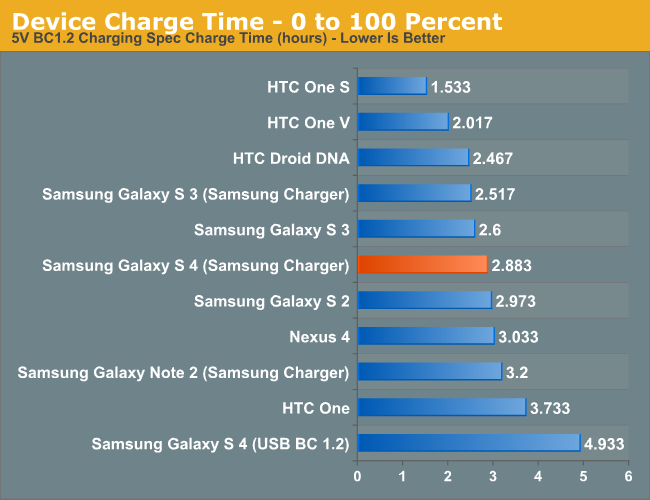


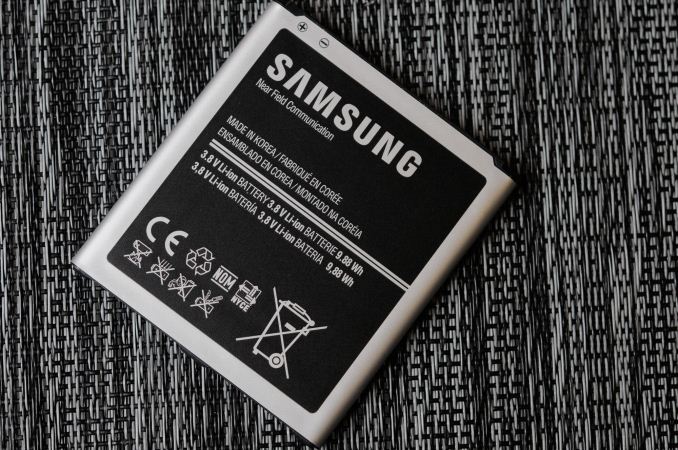








335 Comments
View All Comments
krumme - Wednesday, April 24, 2013 - link
Comparing at 200 nits, is fine, but at that brightness you actually get a more contrasty picture of Oled because of the darkness. For all practical usage - depending on your eyes - you can turn brightness relatively more down on the Oled.You might note that the color accuracy of the S4 is far better than the One. Thats not to mention the contrast. Ofcourse it lacks the brightness. But the presentation here is one sided.
If you find yourself at bars at night or shooting food at the restaurant go for the One camera. But before you do, you might want to compare the pictures plenty available on the net on fx. gsmarena or phonearena
UpSpin - Wednesday, April 24, 2013 - link
If the surrounding is bright, you need a bright display, which OLED struggles at, even with a better contrast, which gets more and more negligible the brighter your surrounding is. At night however you really see the difference between the true black OLED and greyish LCD.I don't know how to properly interpret the color charts, so I judge by the impression of the author which favors the HTC One display (see the HTC One review and this review 'Admittedly this mode does tighten things up a bit, but it still isn't perfect and I'd still like to see Samsung do something to reign this in at some point. ') and the numbers in the article:
HTC One vs. SGS4
Grayscale 200nits Avg dE2000: 5.391 vs. 7.511
CCT Avg (K): 8118 vs. 7020
Saturation Sweep Avg dE2000: 3.365 vs. 7.823
GMB ColorChecker Avg dE2000: 4.656 vs. 7.440
The color charts seem to look better for the SGS4, the 'Total gamma' and greyscale charts however disastrous.
krumme - Wednesday, April 24, 2013 - link
For practical usage i agree the brightness for most people can be an issue in sunlight. We just have to remember there is much more at play here than just brightness.But at the same way using a phone in bright surroundings favor the saturation of Oled.
I never understand the standard setting on the S2 or S3. It gave stupid colors imho (and the sharpness wasnt there either imho compared to LCD competition). But if you chose fx. natural on the S3 i think you are pretty much where the colors is okey for everything personal. Its the grey scale that suffers - the shaddow details is very bad imho. Apparently thats still an issue on the S4.
But the basic problem about reviewing the display this way, is that we get zero numbers for the all important dynamics of the picture. And its just so obvious for the eye that oled got something here.
nerd1 - Wednesday, April 24, 2013 - link
What matters is the perceived CONTRAST, not the brightness itself.Practically AMOLED has better contrast overall, which helps sunlight reading a bit although bit dimmer.
sigmatau - Thursday, April 25, 2013 - link
I feel you are just guessing based on what you see on paper. My Samsung AMOLED plus screen is useless in the sun with full brightness. Most reviewers said that the HTC's screen kills the S4's screen. I am thinking of buying an HTC One and trying it out for a day or two before deciding. I really do like the blacks on OLED screens.krumme - Thursday, April 25, 2013 - link
Nonsense. Plenty sites gives the edge to Samsung. But i guess most just turn the autopilot on. Something happened since your amoled screen. Sunlight legibility is a personal matter, because reflection also plays a big role.sigmatau - Thursday, April 25, 2013 - link
Bull shit. My OLED screen is the best with Nokia's superior filter and still is terrible in the sunlight. I have to find shade just to use the phone. And remember, mine is a plus OLED screen, these on the S3 and S4 are not, which makes them worse.UpSpin - Thursday, April 25, 2013 - link
The glass reflects a lot of the sunlight.The display must be brighter than the reflections to remain readable. That's independent of contrast in the first place. So either reduce the reflections (AR coating, Nokia polarisation) or increase the brightness. The contrast isn't important in the first place here. OLEDs have a lower brightness than LCD, thus, and just as every review talking about outdoor use agrees with, LCD is much better readable outdoors.If you have a very dark display with an impressive contrast you won't see anything in sunlight, because the reflections are much brighter than the content on your display.
Special outdoor display also don't just have RGB, but RGBW, just to make it even brighter for outdoor use.
krumme - Thursday, April 25, 2013 - link
Go here to see an measurement of sunlight contrast ratio:http://www.gsmarena.com/samsung_galaxy_s4-review-9...
S4 is quite good, and if i recall about the same order as One.
ssj3gohan - Wednesday, April 24, 2013 - link
Wait a sec... you have an LTE/HSPA synthesizer, right? Why don't you try out battery life with that, so you're guaranteed to have equal signal strength, bandwidth and latency throughout the tests instead of having to rely on different vendors, signal quality and concurrency.